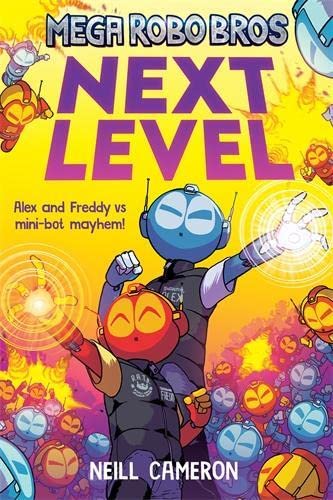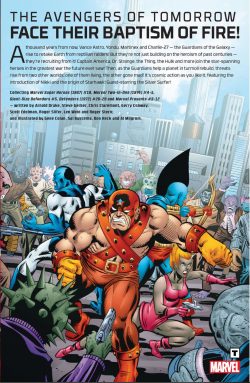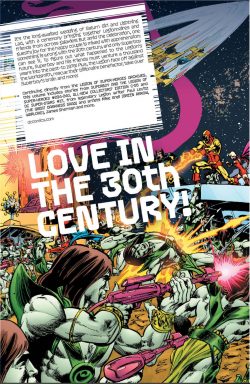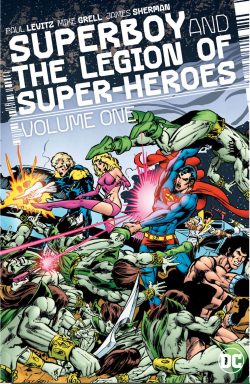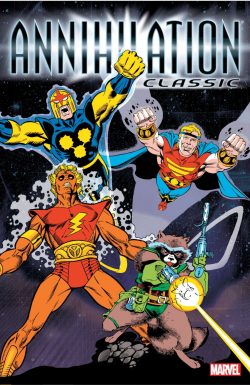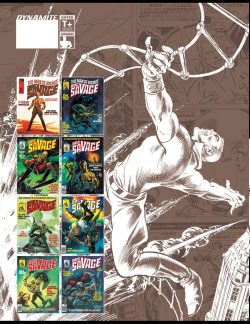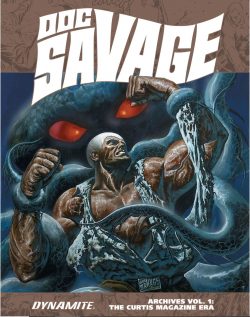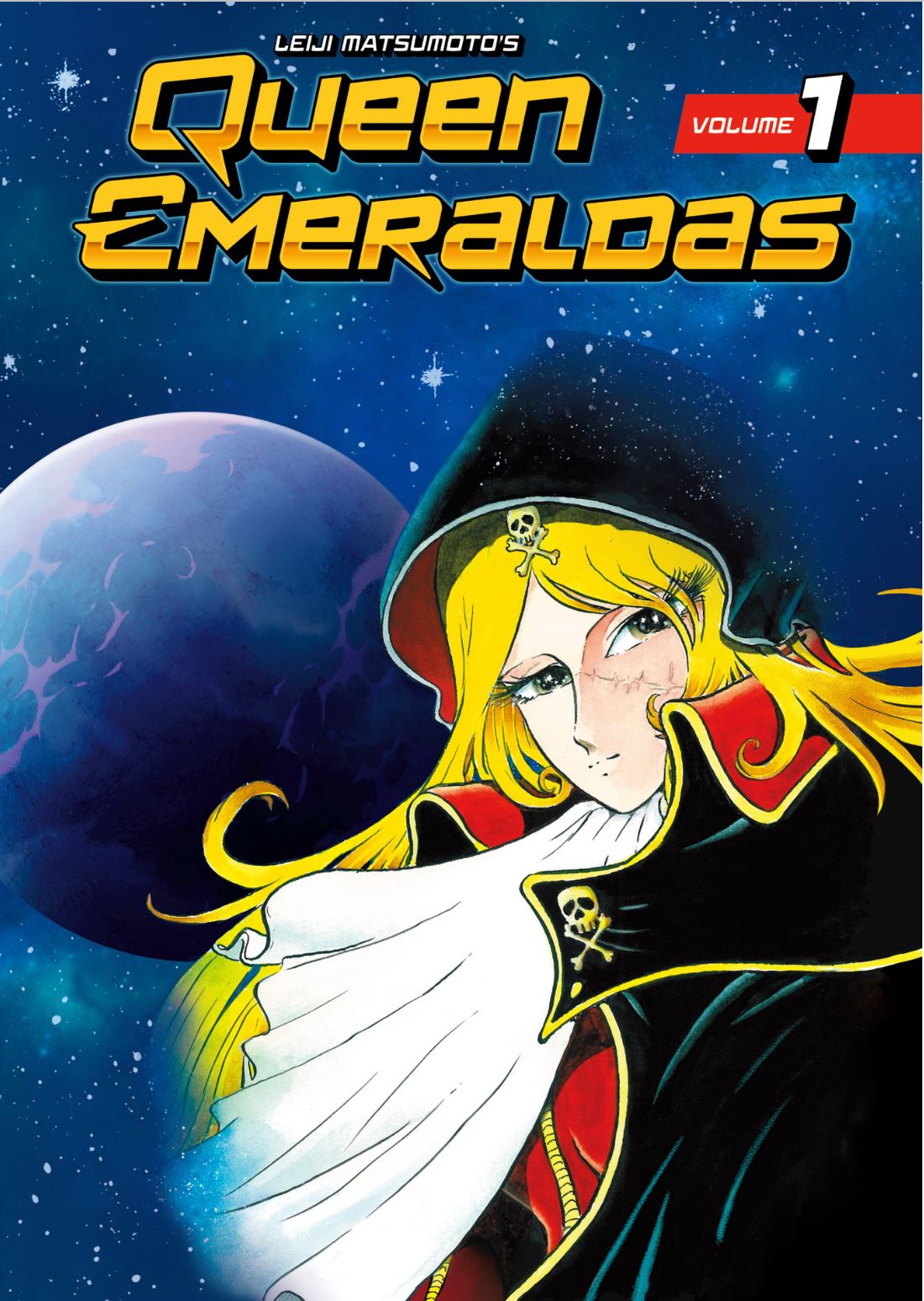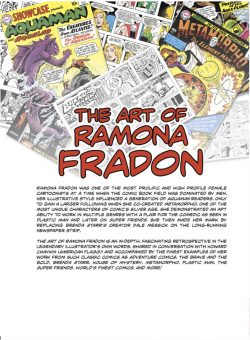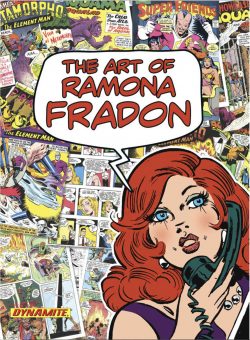

By Dan Abnett & Andy Lanning, Paul Pelletier, Rick Magyar & various (Marvel)
ISBN: 978-0-7851-3326-1 (HB/Digital edition) 978-0-7851-3338-4 (PB)
Following twin cosmic catastrophes (the invasion of our cosmos by the Negative Zone legions of Annihilus and consequent incursion of the shattered survivors of parasitical Phalanx) Marvel breathed new life in many of its moribund cosmic comics characters, and none more so than the rough agglomeration of rootin’, tootin’, blaster-shootin’ outer space reprobates that formed a new 21st century iteration of the Guardians of the Galaxy.
Although heralded since its launch in the early 1960s with making superheroes more realistic, Marvel Comics also maintained its intimate affiliation with outlandish and outrageous cosmic calamity (as wonderfully embodied in their pre-superhero “monster-mag” days), and with an upcoming big-budget movie imminently expected this was a property the company needed to keep in the public eye…
The original Guardians were created by Arnold Drake in 1968 for try-out title Marvel Super-Heroes (#18, cover-dated January 1969): a rag-tag bunch of future-based freedom fighters dedicated to liberating star-scattered humanity from domination – if not extermination – by the sinister Brotherhood of Badoon.
Initially unsuccessful, the space squad floated in limbo until 1974 when Steve Gerber incorporated them into Marvel Two-In-One #4 & 5, Giant Size Defenders #5 and The Defenders (#26-29, July-November 1975), wherein assorted 20th century champions voyaged a millennium into Tomorrow to ensure mankind’s very survival.
This in turn led to the Guardians’ own short-lived series (Marvel Presents #3-12: February 1976-August 1977) until abrupt cancellation left them roaming the Marvel Universe as perennial guest-stars in such titles as Thor, Marvel Team-Up, Marvel Two-in-One and The Avengers. In June 1990 they were back again, securing a relatively successful series (#62 issues, plus annuals and a spin-off miniseries) until the axe fell again in July 1995.
This isn’t them; this is another bunch…
By 2006, reading tastes had once more turned to sky-watching and a massive crossover event involving most of Marvel’s space specialists erupted throughout the Marvel Universe. Annihilation – brainchild of writing team Dan Abnett & Andy Lanning, resulted in a vast reconfiguration (pre- configuration?), creating a set of Galactic Guardians for modern times and tastes.
Among the stalwarts in play were Silver Surfer, Galactus, Firelord (and other heralds of the world-eater), Moondragon, Quasar, Star-Lord, Thanos, Super-Skrull, Tana Nile, Gamora, Ronan the Accuser, Nova, Drax the Destroyer, and a Watcher as well as a host of alien civilisations including the Kree, Skrulls, Xandarians, Shi’ar, and more, all relentlessly falling before an invasion of rapacious Negative Zone bugs and beasties unleashed by undying insectoid horror Annihilus.
That conflagration spawned its own wave of specials, miniseries and new titles and – inevitably – led to a follow-up event…
In Annihilation: Conquest – with Kree and Skrull empires splintered, the Nova Corps of Xandar reduced to one single operative, and wild, ancient gods returned – a sizable proportion of those Negative Zone invaders had tenuously established themselves in territories once home to untold billions.
The Kree Supreme Intelligence was gone and arch-traitor Ronan had become a surprisingly effective ruler of the empire’s remnants. Cosmic Protector Quasar was dead, and Phyla-Vel, (daughter of the first Captain Marvel) had inherited both his powers and title…
Whilst she and psychic demi-goddess Moondragon worked with pacifist Priests of Pama to relieve the suffering of starving survivors, Star-Lord Peter Quill toiled with Ronan to shore up battered interstellar defences of the myriad races in the decimated space-sector.
Quill then brokered an alliance with the Spaceknights of Galador (an old and noble cyborg species most famously represented by 1980s hero Rom) to enhance the all-pervasive etheric war-net, unaware that the system had been treacherously compromised.
When activated, it instantaneously overwrote its own protocols, installing malware that left everywhere ruled by a murderous, electronic sentient parasitic species known as the Phalanx. Their cybernetic credo was “peace and order through assimilation”…
Once again a rag-tag rabble desperately united to repel a cosmic invasion, with Quill commanding a Kree resistance division/Penal Strike Force. The highly engaging intergalactic Dirty Half-Dozen comprised Galactic Warrior Bug (originally from the 1970’s toy/comic-adaptation phenomenon The Micronauts); the current Captain Universe, Shi’ar berserker Deathcry, failed Celestial Madonna Mantis, anamorphic outsider Rocket Raccoon and magnificently whacky “Kirby Kritter” Groot – a Walking Tree and one-time “Monarch of Planet X”.
In combination with stellar stalwarts Drax, “Deadliest Woman in the Galaxy” Gamora and Adam Warlock, the organic underdogs and other special all-stars turned back the techno-parasites and were left to set the saved, badly battered universe back on an even(ish) keel…
The success of all that intergalactic derring-do led in turn to a new series with this initial tome – collecting from July-December 2008 Guardians of the Galaxy (volume 2) #1-6.
It begins with some of the recently acquainted adventurers in the midst of saving the universe a little bit more…
‘Somebody’s Got To Do It’ (by Abnett & Lanning, with art by Paul Pelletier & Rick Magyar) reveals how – thanks to fellow human Nova’s prompting – Star-Lord determined to create a pro-active defence force to handle the next inevitable cosmic crisis as soon as it starts.
To that end, he convinced Drax, Gamora, Groot, Phyla-Vel, Warlock and the raccoon to relocate with him to pan-species science-station Knowhere (situated in the hollowed-out skull of a dead Celestial Space God) to start putting out a never-ending progression of interstellar brush-fires before they become really serious…
The station is guarded and run by Cosmo – a Russian dog with astounding psionic abilities – and is where old comrade Mantis now works as chief medic. It also offers unlimited teleportational transport which the team needs as it tries to prevent an out-of-control Universal Church of Truth Templeship crashing into a time/space distortion and shredding the fabric of reality…
Soon the surly scratch squad are battling savagely crazed missionary-zealots – powered by the worship of enslaved adherents channelled through the vessel’s colossal Faith Generators whilst desperately attempting to divert it before it impacts the fissure in space. Such a collision would cause catastrophic destruction across the galaxy, but the UCT crusaders only see heretics interfering with their mission to convert unbelievers…
The crisis is exacerbated by another small problem: there are very nasty things on the other side of the fissure that really want to come and play in our universe, and when one of them breaks through, the only thing to do is sacrifice the entire ship…
In the aftermath, Warlock reveals that the string of cosmic Armageddons has fundamentally damaged the nature of space, and more fissures will certainly appear. He wants to repurpose the team to find and close them all before anything else escapes.
And on Sacrosanct, homeworld of the Universal Church of Truth, the Matriarch issues a decree for her Cardinals to deal with the interfering unbelievers…
‘Legacy’ sees the squad dash into another Reality rupture which has recently spewed out a huge chunk of limbo-ice, only to find the temporal effluvia is encasing a chunk of Earth’s Avengers Mansion and another appalling atrocity hungry for slaughter. As it attacks, they are saved by a rapidly-thawing, time-lost costumed champion hurling a circular shield with concentric circles and a single star…
The confused hero says he is Vance Astrovik – Major Victory of the Guardians of the Galaxy. He has travelled back from the 30th century, but can’t remember why – or if even if he’s arrived in the right reality…
As the mystery man is probed by telepathic, precognitive Mantis, Quill and Warlock drag the team off to seal another Fissure, and are ambushed by a unit of Cardinals as they enter a vast Dyson Sphere where something horrific is hunting…
As pitched, merciless battle breaks out on the Sphere in ‘Beyond Belief’, Mantis and Major Victory are attacked in Knowhere’s sickbay by a being of incredible power. Astrovik calls the assailant Starhawk, but Mantis can’t glean any information about him from any future she can see…
Within the Sphere, the war between Guardians and Cardinals is abruptly terminated as the bio-horror infesting the solar system-sized construct attacks. Trapped and desperate, Gamora is severely damaged when she uses the artefact’s captive sun to destroy it…
Back home in Knowhere to recuperate in ‘Damages’, the squad is caught in the latest of a series of escalating acts of sabotage. However, the real shock comes as amongst the 38 dead are three Skrulls. The rapacious shape-shifting conquerors have somehow infiltrated the many races using the science station…
Apparently able to defeat all the base’s detectors and confound all the telepaths in situ, the reviled pariahs provoke a wave of panic and top cop Cosmo is soon being challenged by Gorani and Cynosure of the Administrative Council, both demanding swift, strong action…
The news sparks a wave of paranoia and panic amongst the inhabitants and mystery man Astrovik is targeted by a mob, leading to Quill’s team being confined to quarters, where Drax overhears a shocking exchange between Star-Lord and Mantis…
The final two issues here form part of a major company-wide crossover but thankfully can stand alone from that event. It all begins with ‘Deception – a Secret Invasion Story’, wherein Drax goes rogue, hunted throughout the station by super-powered cops whilst his team undergo a trial. Of course, with a suffix like “the Destroyer” there’s little reason to trust the big green galoot, and no chance to stop him as he trashes Cynosure’s superteam The Luminals…
Things take a darker turn as Starhawk reappears – this time as a woman – determined to stop the wrong future from happening, as elsewhere, one of group is revealed to be concealing and protecting the dreaded Skrulls,
…And in the bowels of the station Drax expedites his plan to flush out the shape-shifters: after all, everybody knows that they revert to their own forms on death so all he has to do is kill everyone in Knowhere to find them…
The frankly brilliant conclusion occurs in ‘Death – a Secret Invasion Story’ which cleverly and spectacularly wraps up the crossover whilst positioning the assorted heroes for the next major story arc by splitting them up: a fairly natural reaction once the Guardians learn what Quill had Mantis do to create his proposed pro-active strike-force in the days following the Phalanx’s defeat…
This stunning stellar treasure-chest includes a covers-&-variants gallery by Clint Langley & Nic Klein, with a dozen of Langley’s unused Cover Options; a magnificent double-page pencil-art spread by Pelletier plus a Concept Artwork section on the new improved and savagely sinister Starhawk to astound and amaze all lovers of astral action and gritty, funny fantastic fantasy.
Smart, breathtaking adventure with loads of laughs and tremendous imagination, this is superb stuff crucial to your complete enjoyment and, hopefully, set to be re-issued in the wake of the forthcoming major movie…
© 2008 and 2009 Marvel Characters, Inc. All rights reserved.

